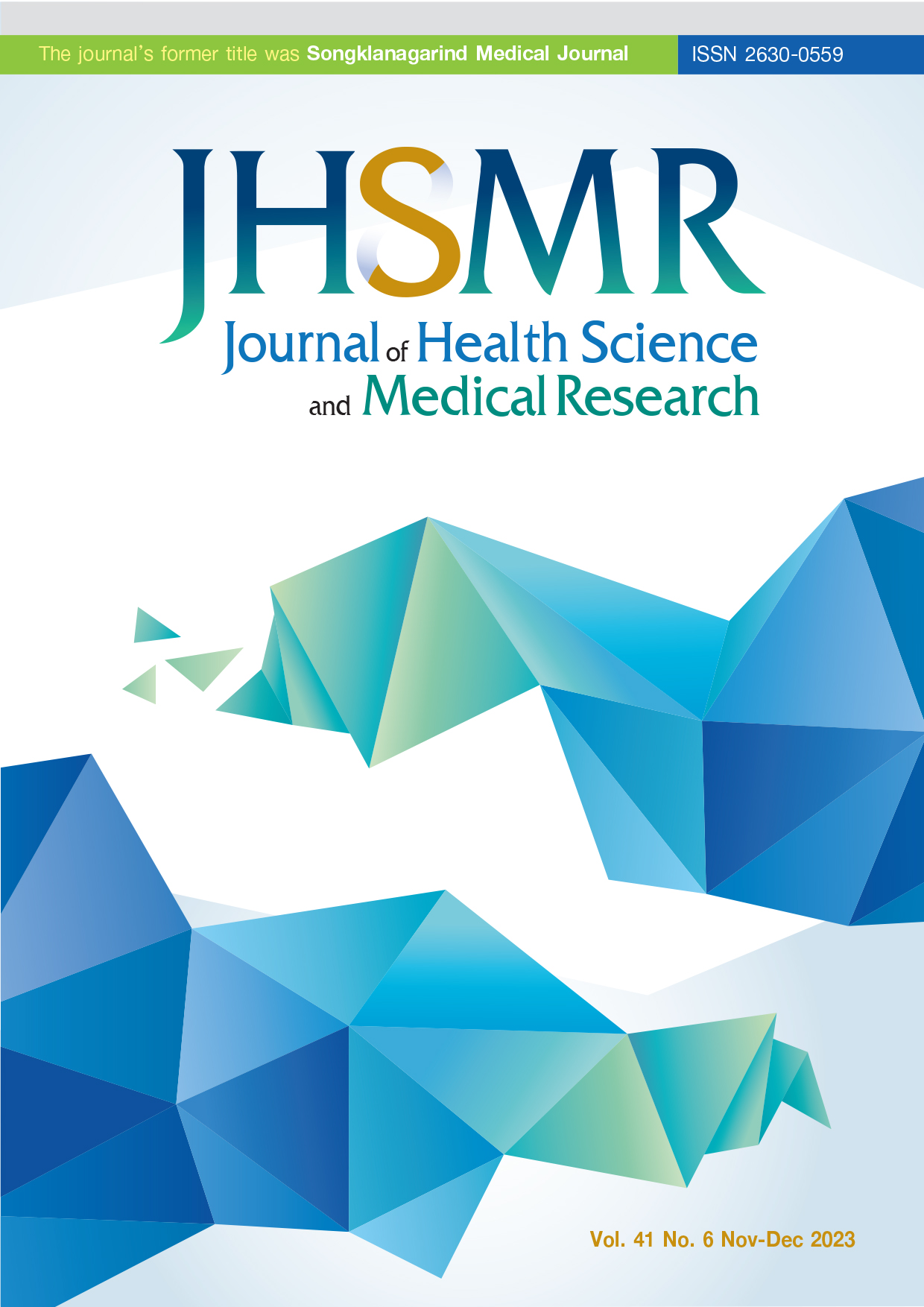Carbapenem-Resistant Enterobacteriaceae Infection in Immunocompromised Children with CRE Colonization: Incidence and Outcomes in an Antibiotic-Limited Setting
DOI:
https://doi.org/10.31584/jhsmr.2023960Keywords:
carbapenem-resistant Enterobacteriaceae, colonization, CRE, meropenem, nosocomial infectionAbstract
Objective: To determine the incidence of carbapenem-resistant Enterobacteriaceae (CRE) infection in patients with CRE colonization and compare the treatment outcomes between febrile patients with non-septic presentation who received empirical treatment with meropenem and those who did not.
Material and Methods: The medical records of febrile patients with CRE colonization aged <15 years who were hospitalized at Songklanagarind Hospital between January 2018 and December 2020 were reviewed.
Results: Among the 61 patients with CRE colonization, CRE infection was identified during eight febrile episodes in six patients (9.8%). Hematologic malignancies, solid tumors, and other diseases were diagnosed in 21 (34.4%), 25 (41.0%), and 15 (24.6%) patients, respectively. The median (interquartile range [IQR]) duration from CRE colonization to the first episode of fever was 22 (1.8–60.8) days. Among the 82 febrile episodes without initial sepsis or central nervous system infection, 19 and 63 episodes, respectively, were initially treated with meropenem and non-carbapenems. Treatment outcomes—including the proportion of patients needing step-up antibiotics (21.1% vs. 36.5%), development of sepsis (5.3% vs. 15.9%), and death within 30 days (6.6% vs. 9.8%) - were not significantly different between the two groups. Patients who developed sepsis had significantly higher resistance to empirical antibiotics (75% vs. 26.3%) as well as a significantly higher incidence of severe neutropenia lasting more than one week (85.7% vs. 21.9%) than those without sepsis.
Conclusion: Patients with CRE colonization who exhibit fever without clinical sepsis and have an absolute neutrophil count >100 cells/mm3 can be empirically treated with non-carbapenems.
References
Logan LK, Renschler JP, Gandra S, Weinstein RA, Laxminarayan R. Carbapenem-resistant Enterobacteriaceae in children, United States, 1999-2012. Emerg Infect Dis 2015;21:2014-21.
Wangchinda W, Thamlikitkul V, Watcharasuwanseree S, Tangkoskul T. Active surveillance for carbapenem-resistant Enterobacterales (CRE) colonization and clinical course of CRE colonization among hospitalized patients at a University Hospital in Thailand. Antibiotics (Basel) 2022;11:1401.
Tunyong W, Arsheewa W, Santajit S, Kong-Ngoen T, Pumirat P, Sookrung, et al. Antibiotic resistance genes among carbapenem-resistant Enterobacterales (CRE) isolates of Prapokklao Hospital, Chanthaburi Province, Thailand. Infect Drug Resist 2021;14:3485-94.
Chiotos K, Hayes M, Gerber JS, Tamma PD. Treatment of carbapenem-resistant Enterobacteriaceae infections in children. J Pediatric Infect Dis Soc 2020;9:56-66.
Tamma PD, Aitken SL, Bonomo RA, Mathers AJ, van Duin D, Clancy CJ. Infectious Diseases Society of America guidance on the treatment of extended-spectrum β-lactamase producing Enterobacterales (ESBL-E), carbapenem-resistant Enterobacterales (CRE), and Pseudomonas aeruginosa with difficult-to-treat resistance (DTR-P. aeruginosa). Clin Infect Dis 2021;72:1109-16.
Hsu AJ, Tamma PD. Treatment of multidrug-resistant gramnegative infections in children. Clin Infect Dis 2014;58:1439-48.
Morrill HJ, Pogue JM, Kaye KS, LaPlante KL. Treatment options for carbapenem-resistant Enterobacteriaceae infections. Open Forum Infect Dis 2015;2:ofv050.
Suay-García B, Pérez-Gracia MT. Present and future of carbapenem-resistant Enterobacteriaceae (CRE) infections. Antibiotics (Basel) 2019;8:1-16.
Paveenkittiporn W, Lyman M, Biedron C, Chea N, Bunthi C, Kolwaite A, et al. Molecular epidemiology of carbapenemresistant Enterobacterales in Thailand, 2016-2018. Antimicrob Resist Infect Control 2021;10:88.
Laolerd W, Akeda Y, Preeyanon L, Ratthawongjirakul P, Santanirand P. Carbapenemase-producing carbapenemresistant Enterobacteriaceae from Bangkok, Thailand, and their detection by the Carba NP and modified carbapenem inactivation method tests. Microb Drug Resist 2018;24:1006-11.
Doi Y. Treatment options for carbapenem-resistant gram-negative bacterial infections. Clin Infect Dis 2019;69(Suppl 7):S565-75.
Chiotos K, Tamma PD, Flett KB, Naumann M, Karandikar MV, Bilker WB, et al. Multicenter study of the risk factors for colonization or infection with carbapenem-resistant Enterobacteriaceae in children. Antimicrob Agents Chemother 2017;61:e01440-17.
Montagnani C, Prato M, Scolfaro C, Colombo S, Esposito S, Tagliabue C, et al. Carbapenem-resistant Enterobacteriaceae infections in children: An Italian retrospective multicenter study. Pediatr Infect Dis J 2016;35:862-8.
McConville TH, Sullivan SB, Gomez-Simmonds A, Whittier S, Uhlemann AC. Carbapenem-resistant Enterobacteriaceae colonization (CRE) and subsequent risk of infection and 90-day mortality in critically ill patients, an observational study. PloS One 2017;12:e0186195.
Sun Y, Yu L, Gao W, Cai J, Jiang W, Lu W, et al. Investigation and analysis of the colonization and prevalence of carbapenemresistant Enterobacteriaceae in pediatric liver transplant recipients. Infect Drug Resist 2021;14:1957-66.
Tischendorf J, de Avila RA, Safdar N. Risk of infection following colonization with carbapenem-resistant Enterobactericeae: A systematic review. Am J Infect Control 2016;44:539-43.
Chiotos K, Tamma PD, Flett KB, Karandikar MV, Nemati K, Bilker WB, et al. Increased 30-day mortality associated with carbapenem-resistant Enterobacteriaceae in children. Open Forum Infect Dis 2018;5:ofy222.
Weiss SL, Peters MJ, Alhazzani W, Agus MSD, Flori HR, Inwald DP, et al. Surviving sepsis campaign international guidelines for the management of septic shock and sepsis-associated organ dysfunction in children. Pediatr Crit Care Med 2020;21:e52-106.
Laoprasopwattana K, Pruekprasert P, Dissaneewate P, Geater A, Vachvanichsanong P. Outcome of dengue hemorrhagic fever-caused acute kidney injury in Thai children. J Pediatr 2010;157:303-9.
Borer A, Saidel-Odes L, Eskira S, Nativ R, Riesenberg K, Livshiz-Riven I, et al. Risk factors for developing clinical infection with carbapenem-resistant Klebsiella pneumoniae in hospital patients initially only colonized with carbapenem-resistant K pneumoniae. Am J Infect Control 2012;40:421-5.
Papadimitriou-Olivgeris M, Marangos M, Fligou F, Christofidou M, Sklavou C, Vamvakopoulou S, et al. KPC-producing Klebsiella pneumoniae enteric colonization acquired during intensive care unit stay: the significance of risk factors for its development and its impact on mortality. Diagn Microbiol Infect Dis 2013;77:169-73.
Lubbert C, Becker-Rux D, Rodloff AC, Laudi S, Busch T, Bartels M, et al. Colonization of liver transplant recipients with KPC-producing Klebsiella pneumoniae is associated with high infection rates and excess mortality: a case-control analysis. Infection 2014;42:309-16.
Laoprasopwattana K, Pruekprasert P, Laosombat V, Wongchanchailert M. Clinical outcome of febrile neutropenia in children with cancer using ceftazidime and aminoglycosides. Pediatr Hematol Oncol 2007;24:595-606.
Suwantarat N, Carroll KC. Epidemiology and molecular characterization of multidrug-resistant Gram-negative bacteria in Southeast Asia. Antimicrob Resist Infect Control 2016;5:15.
Downloads
Published
How to Cite
Issue
Section
License

This work is licensed under a Creative Commons Attribution-NonCommercial-NoDerivatives 4.0 International License.
























